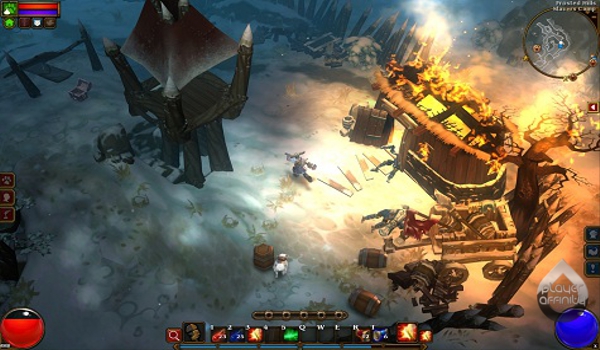It’s fair to say that people all around the world are getting their dose of Action-RPG (ARPG) this week with the release of the long awaited Diablo III. Although people are getting their fix with Diablo, there is another ARPG that should not be overlooked that is right on the horizon – Torchlight II. I got my hands on the Torchlight II beta this past weekend and let me tell you, Torchlight II puts the ‘action’ in action-RPG. Diablo III and Torchlight II may look like they’re very similar on the surface but once you try your hand at both, you’ll see that despite both being ARPGs that they’re very different experiences.

The foremost apparently distinct difference between the two is the way they look. Torchlight II’s aesthetic has a more painterly vibe while the persona of the visuals and the game’s attitude is more like Tim Burton claymation – animated and cartoony, yet dark and melancholy. At first sight it’s apparent that Torchlight II will operate on a wide variety of computing hardware. Despite being on the lighter side of the spectrum regarding system requirements, the aesthetics maintain their integrity and manage to look great while also appearing a bit technically dated. This is a fantastic compromise though because what’s happening on-screen in Torchlight II can get intense and chaotically insane at times. If the gameplay is not taxing your machine, then it will definitely test reflexes and hand-eye coordination of the players.
Although the gameplay is not the first thing you’ll notice that’s different from Diablo, it is definitely the factor that separates the two more keenly. Torchlight II is not so much an Action-RPG as it is a Chaos-RPG. The sheer number of enemies and skills that can be rendered on-screen at any one given moment is pushing the action-RPG envelope, and that’s with only one player in your game. And the best part is that every aspect of the game, down to the very way your pet can go sell items for you in town so you don’t have to leave the action, emphasizes this idea to keep you engaged in the high-octane combat.
Also, just because I say “Chaos-RPG”, the word chaos should not suggest that there isn't a method to this madness. Combat is more tactical than simply smashing your attack keys as the game may appear at first glance. There are enemies that have active blocks that are unable to be damaged unless you break their shields with a powerful or specific skill and there are specific enemies that either resurrect fallen foes or buff them with powerful enhancements. Prioritizing your enemies and knowing what skills to use when and where is the only way to survive the chaos of battle. Also, bosses are particularly awesome and require sharpe awareness to what they’re doing and what hazards they might be unleashing to lay you to waste.
Take a look at some combat and a boss.
Multiplayer is a newly added feature to the Torchlight universe. Anyone who has played Diablo II will feel right at home. There is a lobby with a list of games and you can single-click to see who is in the game and its description, and then you can double-click to enter, granted there is not a password to access that game world. Six people are welcome in a single game at one given time and joining side-by-side combat with friends is as easy as walking to the waypoint in town and clicking on the green checkmark next to your friend's charater name. In multiplayer monsters will become stronger when you have extra people in your party, but not throughout the entire world. Enemies only become more powerful depending on the proximity the players are from one another. Meaning, if one guy is off doing his own thing and you and a friend are nowhere near him, his monsters will not be enhanced by your presence in the game and vice versa.
Beyond the multiplayer and the addition of a few new classes to Torchlight, not much has changed from the first installment. You still gain XP and fame the same way and stat allocation and talent tree distribution works the exact same way as before. There are also general talents and spells that can be acquired and learned via scrolls. Scrolls in combination with your specific class’ talent trees make the game’s class system very flexible, which allows for a lot of room to fiddle with builds and different class specs.
Runic may have some roots that originate back to Blizzard, but it’s clear that Torchlight II has created its own identity to separate itself from its other ARPG competitors. Although, Runic seems to not so much be making Torchlight to compete with its competitors as it is simply creating a game and genre the company loves. Runic’s passions can be seen in Torchlight II in many of its aspects, but by adding the multiplayer that the fans asked for and creating an even more engrossing product for the same minimal fee, the love for the game and the people supporting it really shines through on this one.